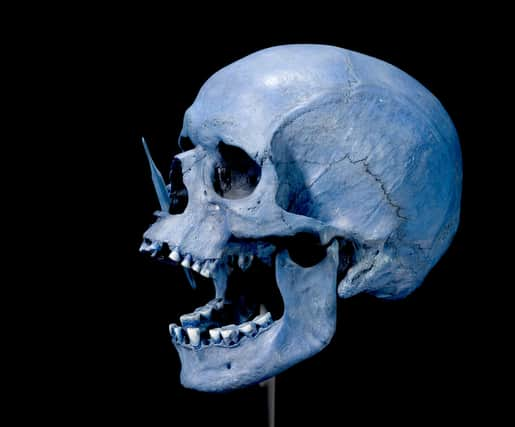Ancient DNA: why does Europe have high rates of sclerosis and Alzheimer’s


The possible reason for high multiple sclerosis and Alzheimer’s disease rates in Europe could be due to ancient DNA.
The bones and teeth of almost 5,000 humans who lived across western Europe and Asia up to 34,000 years ago were mapped out by researchers who have created the world’s largest ancient human gene bank.
Advertisement
Hide AdAdvertisement
Hide AdThe researchers compared ancient human DNA to modern-day samples and mapped the historical spread of genes – and diseases – over time as populations migrated.
The results are published in four research papers in the journal Nature and include the origins of neurodegenerative diseases such as multiple sclerosis, and answers as to why northern Europeans today are taller than people from southern Europe.
Other results suggest that carrying the MS gene was an advantage at the time as it protected ancient farmers from catching infectious diseases from their sheep and cattle and genes known to increase the risk of diseases such as Alzheimer’s and type 2 diabetes were traced back to hunter-gatherers.
Researchers hope future analysis will reveal more about the genetic markers of autism, ADHD, schizophrenia, bipolar disorder, and depression.
Advertisement
Hide AdAdvertisement
Hide AdThe researchers generated DNA profiles ranging across the Mesolithic and Neolithic through the Bronze Age, Iron Age and Viking period into the Middle Ages by analysing the bones and teeth held in museum collections across Europe and western Asia.
They compared ancient DNA data from 1,664 archaeological skeletons with modern DNA from 400,000 people living in Britain, held in the UK Biobank - with the oldest genome in the data from an individual who lived around 34,000 years ago.
According to the research, a genetic predisposition to being tall is likely to have come from the Yamnaya people – livestock herders who migrated over the Pontic Steppe into northwestern Europe. However another finding suggests that disease risk is influenced by how much DNA a person has from the ancient populations that migrated across Eurasia after the last Ice Age.
For example, north-western Europeans carry more genetic risk for multiple sclerosis, while eastern Europeans have an increased genetic risk of developing Alzheimer’s disease and type 2 diabetes.
Advertisement
Hide AdAdvertisement
Hide AdDNA analysis of the prehistoric inhabitants of Eurasia revealed that lactose tolerance – the ability to digest the sugar in milk and other dairy products – emerged in Europe around 6,000 years ago, while the ability to better survive on a vegetable-rich diet was written into Europeans’ genes by the dawn of the Neolithic Age, some 5,900 years ago.
The third Nature paper reveals that genetic differences between ancient populations in western Eurasia were substantially higher than previously estimated, and also much higher than observed in present-day populations and according to researchers, northern Europe has the highest prevalence of MS in the world.
The new study found the genes that significantly increase someone’s risk of developing MS were introduced into north-western Europe around 5,000 years ago by sheep and cattle herders migrating from the east.
Dr William Barrie, a postdoctoral researcher in the University of Cambridge’s Department of Zoology and co-author of the paper, said: “These results astounded us all.
Advertisement
Hide AdAdvertisement
Hide Ad“They provide a huge leap forward in our understanding of the evolution of MS and other autoimmune diseases. Showing how the lifestyles of our ancestors impacted modern disease risk just highlights how much we are the recipients of ancient immune systems in a modern world.”
MS is a neurodegenerative disease in which the body’s immune system mistakenly attacks the insulation surrounding the nerve fibres of the brain and spinal cord.
Professor Lars Fugger, a co-author of the MS study and consultant physician at John Radcliffe Hospital, University of Oxford, said: “This means we can now understand and seek to treat MS for what it actually is: the result of a genetic adaptation to certain environmental conditions that occurred back in our prehistory.”
Scientists traced the geographical spread of MS from its origins on the Pontic Steppe (a region spanning parts of what are now Ukraine, south-west Russia and the West Kazakhstan region).
Advertisement
Hide AdAdvertisement
Hide AdThey found that the genetic variants associated with a risk of developing MS “travelled” with the Yamnaya.
Researchers suggest their findings provide an explanation for the North-South Gradient, in which there are around twice as many modern-day cases of MS in northern Europe as in southern Europe.
The study involved an international team led by Professor Eske Willerslev, at the Universities of Cambridge and Copenhagen, Professor Thomas Werge, at the University of Copenhagen, and Professor Rasmus Nielsen, at University of California, Berkeley, and involved contributions from 175 researchers from around the world.
Comment Guidelines
National World encourages reader discussion on our stories. User feedback, insights and back-and-forth exchanges add a rich layer of context to reporting. Please review our Community Guidelines before commenting.
